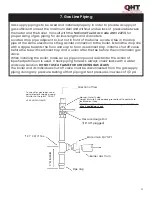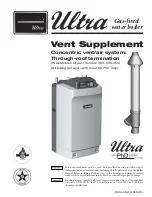
2
Any appliance that burns natural gas, propane gas, fuel oil, or coal is capable of producing
carbon monoxide (CO). Carbon monoxide (CO) is a gas which is odorless, colorless and
tasteless but is very toxic. CO is lighter than air and thus may travel throughout the building.
BRIEF EXPOSURE TO HIGH CONCENTRATIONS OF CO, OR PROLONGED EXPOSURE TO LESSER AMOUNTS
OF CO MAY RESULT IN CARBON MONOXIDE POISONING. EXPOSURE CAN BE FATAL AND EXPOSURE
TO HIGH CONCENTRATIONS MAY RESULT IN THE SUDDEN ONSET OF SYMPTOMS INCLUDING
UNCONSCIOUSNESS.
Symptoms of CO poisoning include the following:
dizziness
vision problems
shortness of breath
headache
loss of muscle control
unclear thinking
nausea
weakness
unconsciousness
The symptoms of CO poisoning are often confused with those of influenza, and the highest
incidence of poisoning occurs at the onset of cold weather or during flu season. A victim may
not experience any symptoms, only one symptom, or a few symptoms. Suspect the presence of
carbon monoxide if symptoms tend to disappear when you leave your home.
The following signs may indicate the presence of carbon monoxide:
IF ANY OF THE SYMPTOMS OCCUR, OR IF ANY OF THE SIGNS OF CARBON MONOXIDE ARE PRESENT,
VACATE THE PREMISES IMMEDIATELY AND CONTACT A QUALIFIED HEATING SERVICE COMPANY, THE
GAS COMPANY OR THE FIRE DEPARTMENT.
ONLY QUALIFIED, LICENSED SERVICE CONTRACTORS SHOULD PERFORM WORK ON YOUR B10 BOILER.
WARNING
• Hot gasses from appliance, venting system pipes or chimney, escaping into
the living space.
• Flames coming out around the appliance.
• Yellow colored flames in the appliance.
• Stale or smelly air.
• The presence of soot or carbon in or around the appliance.
• Very high unexplained humidity inside the building.





































